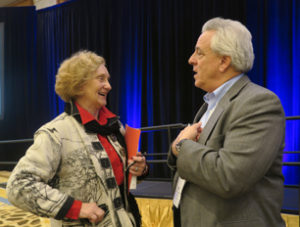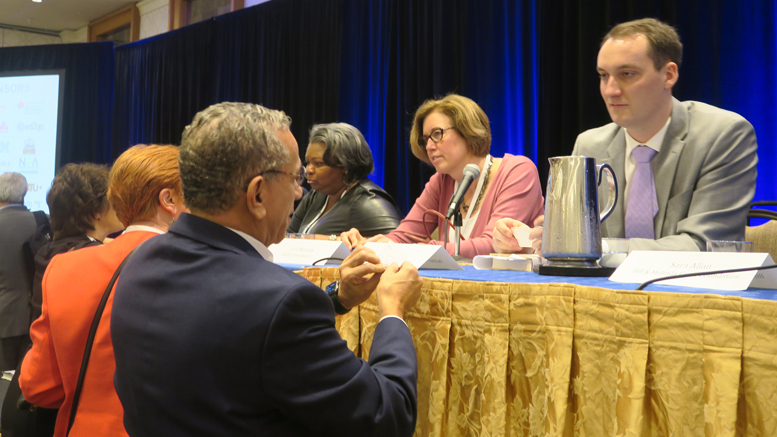NEW ORLEANS — Foundations are playing more of a key role in community college workforce programs than ever.
“There has been a sea change in community college involvement with foundations,” said Sandra Kurtinis, president of the Community College of Baltimore County (Maryland) and chair-elect of the American Association of Community Colleges’ board of directors, at a plenary session she moderated at AACC’s Workforce Development Institute (WDI).
“Foundations understand everything we do is workforce development,” Kurtinitis said. Foundations are behind several of AACC’s major initiatives, from the Bill & Melinda Gates Foundation’s support of the Pathways Project to the Lumina Foundation’s support for the Right Signals Initiative.
“Our partners are speaking the same language we are, and they are seeking to serve the same people we do,” Kurtinitis said.
A K-16 perspective
The Gates Foundation is shifting its focus in education from K-12 programs to higher education – and is specifically targeting community colleges, including such issues as college completion, student advising and financial aid, said Sara Allan, deputy director for K-12 programs. The foundation is taking a K-16 perspective and working on improving the connection between K-12 and higher education, with the goal of ensuring students are career ready.
Rapid changes in the economy results in less clarity about how credentials translate in the labor market, Allan said. Academic skills are still necessary but have become insufficient; soft skills, job training and work experiences are important, too. Just getting more people into four-year colleges doesn’t mean they qualify for high-wage work.
“The challenge for higher education is to put all these things together,” Allan said. “We’re interested in innovative models that help us all work together.”
Since the foundation doesn’t have the resources to help every locality, it is investing in shared resources – by accelerating innovation to reduce costs, sharing technical assistance, creating networks, developing policies and incentives, and creating data platforms.
A focus on skills
Skillful, an initiative of the Markle Foundation, leverages technology to connect workers to good-paying middle-skill jobs. The focus is on skills, rather than degrees, said Senior Manager Drew Petty.

Sandra Kurtinis, Community College of Baltimore County president and AACC board of directors chair-elect, and Eric Seleznow, senior advisor at Jobs for the Future.
Skillful began this effort by convening thought leaders to discuss “how to change the entire labor system” and how to develop a model that can be shared, Petty said.
“There’s a lack of clarity,” he said. People entering the job market don’t know what to expect. Skillful and its partners are working on aggregating graduation and wage data from the federal government and sharing the results with colleges so people can have a better idea of what employers want, what skills they should have, and what kinds of opportunities are available.
According to Petty, when the Community College of Aurora in Colorado was able to make use of this data, “the program has seen an improvement in placement due to better alignment to industry needs.”
“We’re trying to create a holistic pathway for people seeking jobs,” Petty said. “The idea is to create a cohesive system that is changing the mechanics of the labor market, not just getting people into a job.”
Training older adults
AARP Foundation’s workforce initiative is focusing on encouraging employers to hire older adults. Research shows that companies with “age diversity” have higher workforce performance and less turnover, said program manager Lori Strauss. And if older Americans can maintain employment as long as possible, they will be less likely to slip into poverty.
There are obstacles, however, including the need for upgraded skills and for ensuring employers understand the special needs of older workers, such as simplifying instructions for them.
“Age discrimination is real,” Strauss said. The idea that older people can’t learn new skills is an outdated stereotype.
AARP Foundation developed a Back to Work 50+ Network in partnership with AACC to help 12 community colleges reach out to older adults, enroll them in college programs, and help them connect with jobs.
AARP Foundation is currently expanding these efforts through program support and materials to community colleges committed to serving the older worker population.
A focus on completion
Lumina Foundation is concentrating on just one objective: supporting initiatives to raise the college completion rate. Its goal calls for at least 60 percent of Americans to have a higher education credential by 2025.
To get there, Lumina is reaching out to African-Americans, Native Americans, Hispanics, traditional-age students and adults. That includes the 2 million people over age 25 who have some postsecondary credits but no credential and the 3.5 million adults with no experience in higher education, said Strategy Officer Nicole McDonald. The foundation is increasingly looking toward community colleges to reach those populations.
If nothing is done, the nation will be 16 million short of the goal by 2025. “We can’t get there without you,” McDonald told community college leaders at WDI.
Lumina’s approach, spelled out in its strategic plan, is all about scaling innovation, McDonald said. “We’re trying to work really fast and really big. We are focused on systemic change. We cannot get there one college at a time.”
The foundation is working with AACC on such projects as the Right Signals Initiative because “The students you serve are the kinds of students we are prioritizing in our plan to increase attainment,” she said.
One barrier for potential students is the lack of information about how to access postsecondary education; another is the lack of resources – so those are two areas Lumina is targeting. The foundation is also focused on quality assurance, not just numbers, and on all types of credentials, rather than just degrees.
Lumina’s Credential Engine initiative is geared to make it easier for people to know what credentials are available and how to attain them.
Targeting the disadvantaged
The Conrad N. Hilton Foundation’s main goal is to help the nation’s most vulnerable and disadvantaged people through systemic change and partnerships, said Sam Spiewak, program associate for domestic programs.
The foundation launched a hospitality workforce initiative in 2015 targeting people in the New Orleans area age 18 to 24 who are not in school and unemployed. There are some 57,000 people in that category, Spiewak said.
Delgado Community College is a partner, along with the New Orleans Workforce Development Board, New Orleans Business Alliance and Liberty’s Kitchen, which provides workforce and life skills training to disconnected youths.
In addition to preparing students for jobs in the hospitality industry, the Hilton Foundation’s program works on eliminating obstacles by ensuring students have transportation and childcare. Ultimately, the goal is to develop transferable skills, not just training people for entry-level jobs, Spiewak said.
“We are interested in innovation,” he said. “It takes patience to develop partnerships based on trust.”

